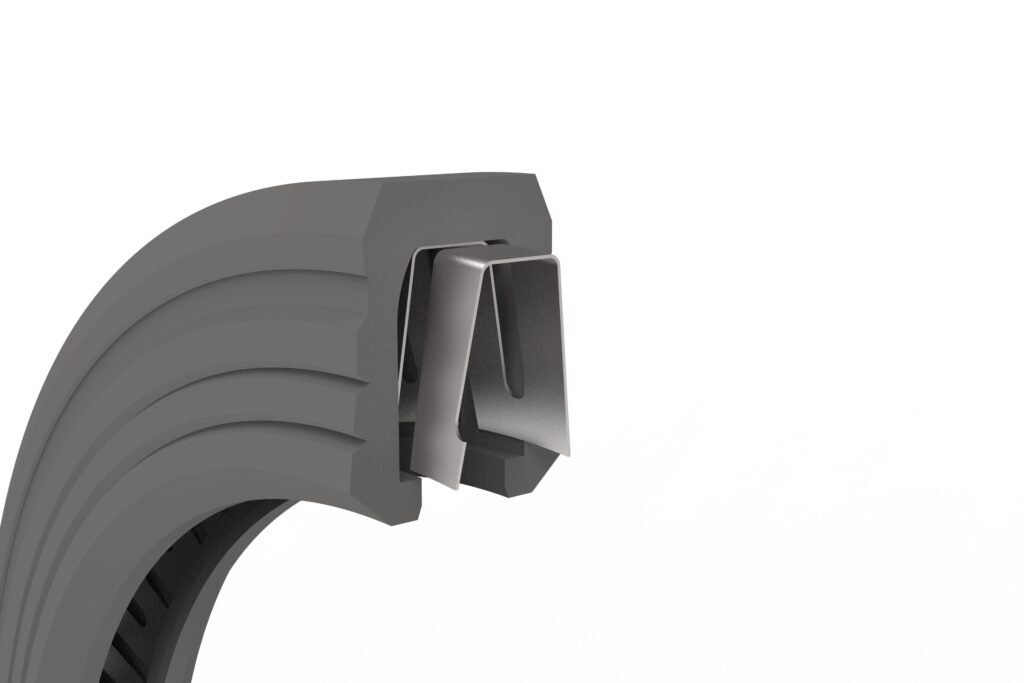
The Engi-Seal Face RV6 offers a low wear rate and redundant sealing lips to ensure durability and reliability. Trapped fluid between the contact points provides additional lubrication, enhancing the seal’s performance. However, it is not suitable for dynamic sealing of abrasive media and may experience weeping in high-speed reciprocating applications due to seal lip hydroplaning.
The Engi-Seal Face RV6 is ideal for applications that demand high reliability and redundancy in sealing performance. Multiple lipped seals are commonly used in gearboxes, automotive applications, and equipment operating in dirty or dusty conditions.
Most spring-energized sealing profiles are designed to be compatible with the three primary spring types. Understanding the differences between these spring types is essential for making informed engineering decisions, particularly in relation to each spring’s load versus deflection characteristics.
Load vs. deflection characterizes how a seal’s spring energizer responds under compression, providing a measure of the force (load) required to achieve a certain deformation (deflection) of the spring element within the seal. This response is pivotal for ensuring adequate sealing pressure against the mating surface throughout the operational life of the seal, compensating for wear, hardware tolerances, and thermal expansions or contractions.
Each spring type can be customized to provide different load profiles depending on the specific load requirements:



Understanding these spring types and their specific applications can help you make informed decisions for optimal sealing performance.
Materials: Available in 302 SS, 316 SS, Alloy C-276, Beryllium Copper, and other alloys. Offered with gold, silver, and nickel plating for electronic and semiconductor applications. Radial cross-sections from 1/32″ to 3/8″, with diameters as small as 0.050″.
Material Benefits:
| Specification | Details |
| Pressure Capacity | Maximum of 3,000 psi. Pressure can vary significantly depending on spring choice. |
| Temperature Range | -270°C to +260°C | -450°F to +500°F |
| Material | Description | Temperature Range | Wear Resistance | Extrusion Resistance | Abrasion to Shaft |
| Unfilled PTFE | Suitable for light-duty service with the lowest friction and excellent chemical compatibility. It is FDA compliant and white in color. | −450°F to 450°F (−270°C to 230°C) | Low | Low | Low |
| 1130 | 1130 is a polymer and carbon filled PTFE (polytetrafluorethylene) material that is significantly softer than most other carbon filled PTFE’s, but it is a much better sealing material with good wear properties. This material has excellent tensile strength and elongation for PTFE based materials. This material is specifically designed for demanding sealing/wear applications where PTFE is deemed appropriate. | −450°F to 450°F (−270°C to 230°C) | High | Medium | Low |
| Graphite-Filled PTFE | Designed for light-duty service with low friction and very good chemical compatibility. It has good wear resistance in liquids and humid conditions. The color is black. | −450°F to 475°F (−270°C to 230°C) | Low | Low | Low |
| Graphite-Carbon-Filled PTFE | Suitable for general light-duty applications with low friction and very good chemical compatibility. It has good wear resistance in liquids and humid conditions. The color is black. | −450°F to 500°F (−270°C to 230°C) | Medium | Medium | Low |
| 1215 | 1215 is a proprietary, polymer and carbon filled PTFE (polytetrafluorethylene) material. In addition to retaining the exceptional chemical resistance, heat resistance, corrosion resistance, and low friction properties of unfilled PTFE, it also offers significantly improved compressive properties, better wear properties, and low creep under load. It is ideal for oilfield applications as it can effectively handle down-hole chemicals, hydrocarbons, oils, mud, and slurries. Primarily, it is used for dynamic sealing components, such as face seals, packing, riders, and V-packing. It is a significant upgrade from carbon filled PTFE materials normally used in these applications. | −450°F to 500°F (−270°C to 260°C) | Medium/High | High | Medium |
| Moly-Glass Filled PTFE | For extreme conditions, offering excellent extrusion resistance but may be abrasive to soft mating materials. The color is black. | −450°F to 500°F (−270°C to 260°C) | High | High | High |
| Glass-Filled PTFE | Glass fiber improves the wear properties of PTFE, lowers the deformation under load at both high and low temperatures, and increases the impact resistance while leaving the electrical and chemical characteristics of PTFE essentially unchanged. It is suitable for piston rings, valve seats, shaft seals, electrical insulators, bearing pads and gaskets. This material should not be used in contact with strong alkalis and hydrofluoric acid. | −450°F to 500°F (−270°C to 260°C) | High | High | High |
For comprehensive support on housing details or to explore potential solutions tailored to your application, we invite you to book a meeting with us
